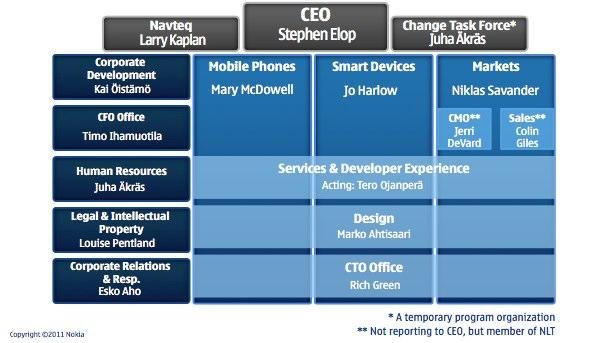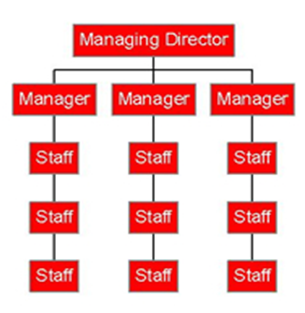Executive Summary of Nokia Business Groups
An organization is defined as an integration of processes with a single purpose; to attain the expected goal of an organization, management needs to develop and effective working organizational structure. An effective organizational structure looks into qualitative and quantitative issues of the structure were it ensures that both human resources matters and physical combination of resources have been addressed accordingly.
Nokia is an international phone company that is currently leading in the phone segment of the electronic market in the world; the company’s organizational structure has enabled it to command the success it has attained.
As time goes, the structures of the company are becoming week calling for immediate actions to be taken to retain the glory of the company. The main areas that need to be looked into include the strategic alliances division, innovation and invention section of the company, and the organizational culture adopted by the Company.
Introduction: Nokia Structure
The success of an organization depends on how well physical and human resources of the organization have been organized and managed. Organizational theory emphasizes that every organization has potential to become competitive in its industry if it organizes the assets, both physical and intangible, that it has.
Leaders have the role of developing an organizational structure, which is the framework of operation in the organization, effectively developed structures ensures that resources are effectively managed, customers are satisfied, human resources are well managed, and all stakeholders are satisfied with the position of the organization.
An organizational structure has a total quality approach where all areas of the organization are addressed; despite this totality approach, changes in business environments and industries have sometimes made companies to find their strategies ineffective and irresponsive of current business policies (Wheelen & Hunger, 1998). Nokia is an international phone company, with its headquarters in Finland.
The company currently enjoys a market share of about 37% and aims at increasing the market share to over 40% by the end of 2011; however, the company is facing a number of strategic issues, which has made its profits and sales reduce in the recent past and overtaken by Apple Inc. products.
This report is an analysis of organizational structure of Nokia Phone Company; the report will analyze the current structure of the company and current strategic issues facing the company.
Nokia is divided into four main departments where every department, also called business group, is given some mandate to undertake, the departments are Mobile Phones; Multimedia; Enterprise Solutions and Networks; other than the departments, the company has two horizontal departments as Technology Platforms and Customer and Market Operations.
Neither the business group nor the horizontal department work independent, however they are interdependent with each other, the following chart shows the companies organizational culture:
- Chart 1

Each manager or departmental head is responsible for his area and is expected to work for the good of the entire firm.
As strategic tool, Nokia have realized the need to have an effectively managed human capital; a company requires both physical and human resources for its operations; human resources are the greatest asset that an organization can have; without it, no business transaction can take place.
It ensures that the business is run in the right way, and thus determines the current as well as the future state of the business (Bateman & Snell, 2011).
Nokia has a human resources management department with the role of ensuring staff needs have been addressed effectively, the department has the role of ensuring that the company has the right number of human capital at the right time at an appropriate cost.
It has the mandate of planning, deploying, employing, training, retaining, and dismissal of employees. When the department is undertaking this duty, it looks into quantitative and qualitative aspects. Qualitative means the right number of employees and qualitative means employees with right skills.
Managing human resources has been an ignored area in traditional business management, however with modern strategic management; managers increasingly understand that the success of their organization is highly dependent with how well they manage their human resources.
When managing human resources, managers ensure that they understand the needs of the human resources and their motivations, when they are well managed, they are sources of creativity, innovations and innovation. Strategic management gurus are of the opinion that organizations that have well managed human resources have an asset over their competitors that can be used for a long time as a source of competitiveness.
Nokia hires from the domestic and international market to ensure that it has the right expertise and have a diverse workforce, with such a people resource the company is able to trade effectively in the local and international markets (Taylor, 2008).
Nokia Organizational Chart
The large number of staffs at Nokia and different management and supervisory levels offers Nokia a tall organizational structure. The diagram below is an illustration of a tall organizational structure similar to that of Nokia.
- Chart 2

The structure is only there to ensure that there is good management and processes within the organization are well managed and controlled.
Despite the company being the largest phone company in the world, the company is facing a number of strategic issues that if not addressed with immediate effect, then the company is likely to lose its competitiveness and dominance in the market; the following are the strategic issues:
- Creating significantly short replacement cycle
Phones are long-lasting equipments and making them as so is one of value and quality assurance of Nokia, however markets are getting saturated with phones thus holding a single phone for a long period of time.
When this happens, then the growth of sales is hampered and the company cannot continue with its sales. In countries like Finland, Europe and some African countries, the company’s products are seen everywhere and the markets are slowly growing.
- Saturation of current markets
The company has its main operating base at Asia, North America and Europe, however these markets are becoming saturated with phones and the markets seems not to be growing. Despite the slowed growth, the markets have a number of international players selling their products in the markets. The company’s sales are not promising in the country as well as the operating costs in these countries is on the upward rise (Kaushik & Cooper, 2000).
- Reluctance in technological innovation
In the recent past, the phone industry has experienced a massive development, other companies like Apple Inc. and Samsung have pioneered however, Nokia, and it have not pioneered the development. The reluctance in the innovation has resulted to Nokia–Apple patent dispute; it has also seen the company become a technology copier (McFarland, Bloodgood and Payan, 2008)
Conclusion: Organizational Structure and Culture of Nokia
With the current success in the international markets, Nokia should be thinking of a brand extension approach: brand extension is a marketing tool used to market products using the strength of an existing brand.
It involves developing of new products, mostly related to the product already in the market, it is a method of widening of the range of products (or services), by riding in the strength of an existing brand. It is a method of optimal brand strength by creating additional sales. It is also a form of increasing Brand Equity.
Brand extension is strategic and should b e timely; when over done it ends to diluting of a brand. The company should be on the high note to have other electronic commodities that can drive the market; the new products that the company can develop include television sets, Radios, laptops, and music equipments.
The new products are likely to b ea driving force for the company; Apple Inc. with the invention and invention of IPods and I-phones the company was able to control a niche market; a diversion from its main line of business that was desktops and computer software development.
References
Bateman, T. S., & Snell, S. A. (2011). Management: Leading & collaborating in a competitive world. New York: McGraw-Hill Irwin
Ketchen Jr., G., & Hult, T.M. (2006). Bridging organization theory and supply chain management: The case of best value supply chains. Journal of Operations Management, 25(2), 573-580.
McFarland, R., Bloodgood, J. and Payan, J.(2008). Supply Chain Contagion. Journal of Marketing, 72(2), 63-79.
Taylor, G.(2008). Lean Six Sigma Service Excellence: A Guide to Green Belt Certification and Bottom Line Improvement. New York: Ross Publishing.
Wheelen, L., & Hunger, J. (1998). Strategic Management and Business Policy: Entering 21st Century Global Society. Massachusetts: Addison Wesley